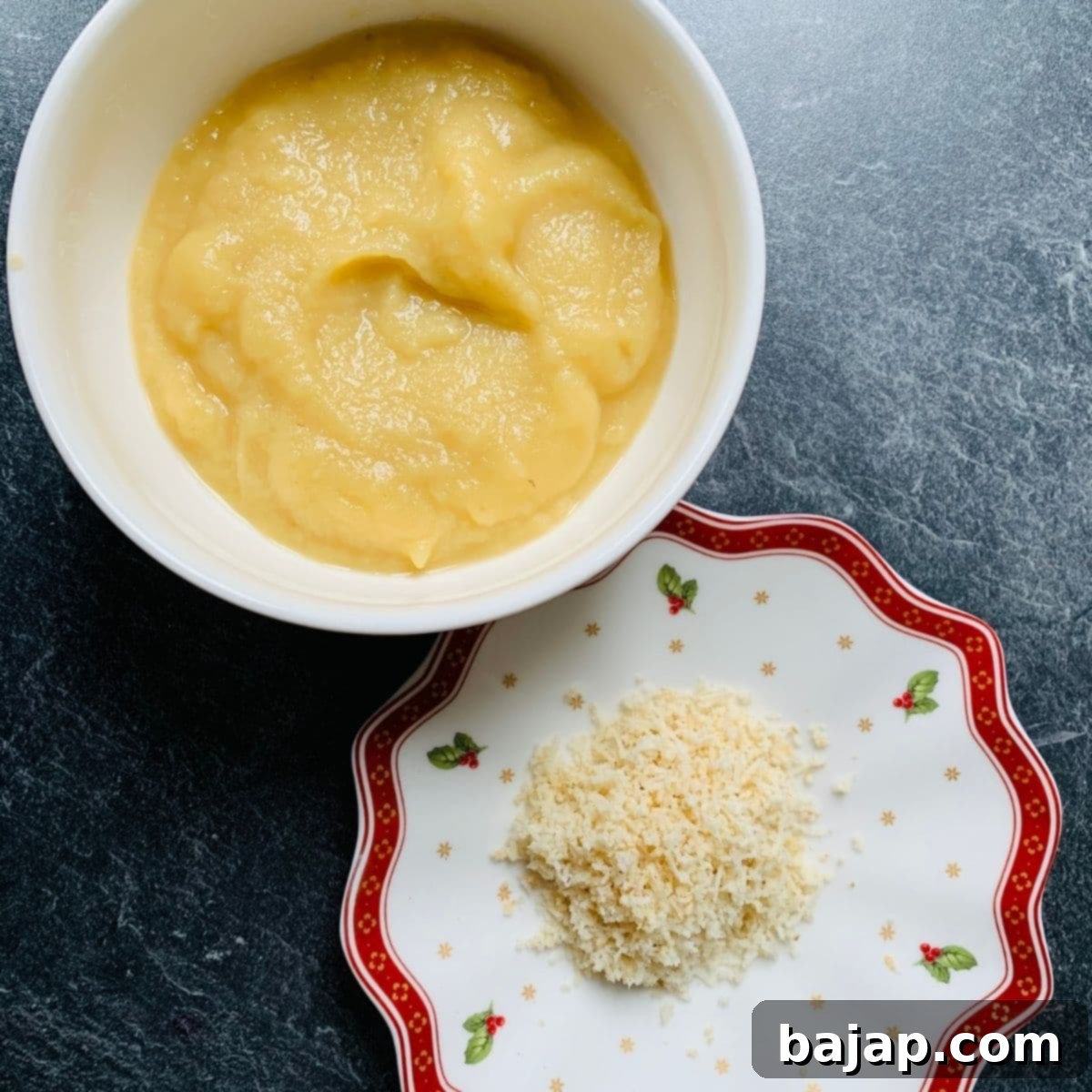Homemade Apfelkren: The Essential Austrian Apple Horseradish Sauce Recipe
Dive into the delightful world of Austrian cuisine with a staple that graces many tables: Apple Horseradish Sauce, known in German as Apfelkren. This exquisite, naturally gluten-free sauce offers a harmonious blend of piquancy and sweetness, elevating a wide array of dishes from festive roasts to everyday grilled favorites. Whether it’s the centerpiece of a Christmassy Tafelspitz (prime boiled beef), a vibrant accompaniment to summer grilled meats, a classic pairing for succulent roast beef or Easter ham, or a surprising twist with a tender air fryer turkey breast, Apfelkren is truly versatile.
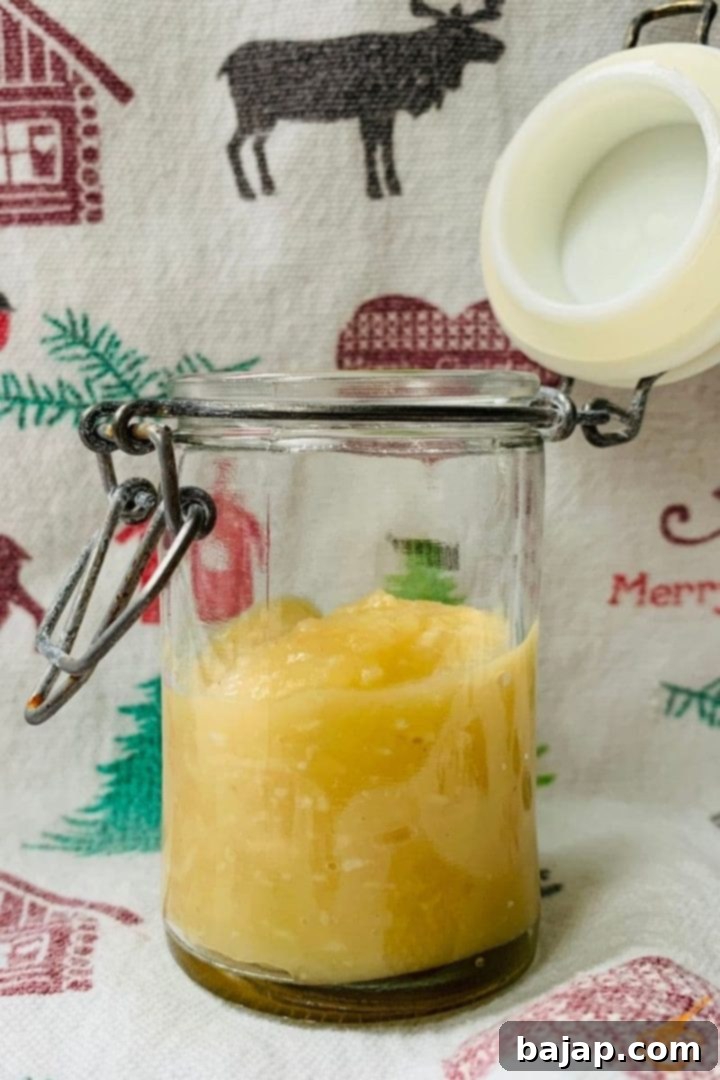
Why You’ll Fall in Love with Apple Horseradish (Apfelkren)
Preparing homemade apple horseradish sauce is an experience in itself, culminating in a condiment that strikes a flawless balance between the vibrant, peppery kick of fresh horseradish and the natural, mellow sweetness of apples. Unlike many store-bought alternatives, this homemade version ensures that neither flavor overpowers the other, allowing both the sauce and the accompanying dish to shine. Its remarkable ease of preparation means you can whip up this sophisticated delicacy in minutes, leaving your guests utterly impressed by your culinary prowess. It’s not just a sauce; it’s a conversation starter, a testament to simple ingredients yielding extraordinary taste.
[feast_advanced_jump_to]
🥘 Simple Ingredients for Exceptional Flavor
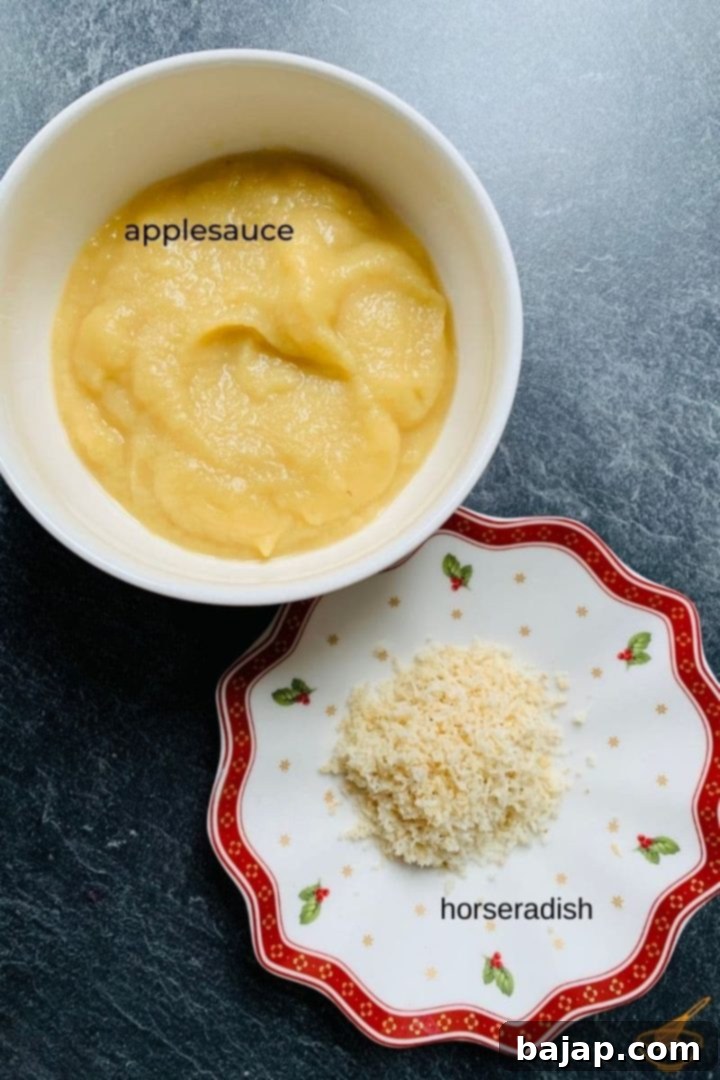
Creating this delicious Apfelkren requires just two primary ingredients, allowing their inherent qualities to shine through. The secret lies in the quality and freshness of these components.
- 12.7 oz (360 g) Apple Sauce (homemade or store-bought): The foundation of our sauce. Choose a plain, unsweetened applesauce if opting for store-bought to best control the sweetness level. If making it yourself, select tart apples for a more balanced flavor profile.
- 2-3 tablespoon Horseradish (freshly grated is highly recommended): This is where the magic happens! The amount can be adjusted based on your desired level of heat and intensity. Always start with less and add more to taste.
Fresh vs. Prepared Horseradish: A Flavor Showdown
While convenience often tempts us towards prepared horseradish found in most grocery stores, I strongly advocate for seeking out and grating fresh horseradish root. The difference in taste and potency is truly remarkable and makes all the effort worthwhile.
Prepared horseradish, in many cases, is not as finely grated and possesses significantly less pungency than its freshly grated counterpart. The volatile oils responsible for horseradish’s signature kick diminish rapidly once grated and exposed to air. This means that a jar of prepared horseradish, while convenient, will likely offer a muted and less vibrant flavor compared to a fresh root.
If you have the opportunity, always choose a fresh horseradish root. When buying, look for firm, unblemished roots without soft spots. A freshly grated root will deliver an unparalleled zesty, spicy, and aromatic punch that simply cannot be matched by pre-packaged options. The unpeeled horseradish root itself can be stored fresh in the refrigerator for a few weeks, allowing you to enjoy its potent flavor whenever you desire, though it’s best used within a week or two for peak flavor. Trust me, your taste buds will thank you for making the fresh choice!
Enhance Your Austrian Feast: Pair Apfelkren with these traditional recipes: Tafelspitz (Austrian Prime Boiled Beef), Erdäpfelschmarrn (Austrian grated pan-fried potatoes), and Chives Sauce.
🍽 Essential Equipment for Apfelkren Perfection
You don’t need a professional kitchen to make this sauce. A few basic tools are all it takes to bring this flavorful condiment to life.
- Small mixing bowl: For combining your ingredients.
- Grater: A fine grater is ideal for achieving the perfect texture. A box grater with a fine side works wonderfully.
- Tablespoon: For measuring and mixing.
- Cutting board: For preparing the horseradish root safely.
🔪 Crafting Your Apfelkren: A Step-by-Step Guide

One of the most appealing aspects of this Apfelkren recipe is its remarkable simplicity and speed. You’ll be amazed at how quickly you can transform these basic ingredients into a gourmet condiment.
- Prepare the Horseradish Root: Begin by carefully peeling the outer skin from the portion of the horseradish root you intend to grate. If you encounter any green sections directly beneath the peel, it’s best to cut these away, as they can introduce an undesirable bitter flavor to your sauce. Once peeled, grate the desired amount of horseradish (typically 2-3 tablespoons, but adjust to your spice preference).
- Grating Technique for Best Texture: For optimal results, hold the horseradish root against the grating surface at a 90-degree angle. This technique helps prevent the root from fraying, which can lead to a stringy, fibrous texture in your sauce – something we want to avoid.
- Ventilation is Key: Be aware that the mustard oils released from horseradish during grating can cause your eyes to water significantly, much like cutting an onion. To mitigate this, I highly recommend grating with a window open or directly under your kitchen’s range hood. This ensures good ventilation and minimizes irritation.
- Combine and Taste: Now, take your chosen applesauce (whether homemade or store-bought) and transfer it into a small mixing bowl. Begin to gradually add the freshly grated horseradish, one tablespoon at a time. The key here is caution and frequent tasting. Mix well after each addition and sample the sauce to achieve your desired balance of sweet and spicy. Remember, you can always add more horseradish, but you can’t take it away! 😉
- Final Mix and Serve: Once you’ve perfected the flavor profile, give the applesauce and horseradish a final thorough mix. And voilà! Your homemade Apfelkren is ready. It’s truly that simple and fast!
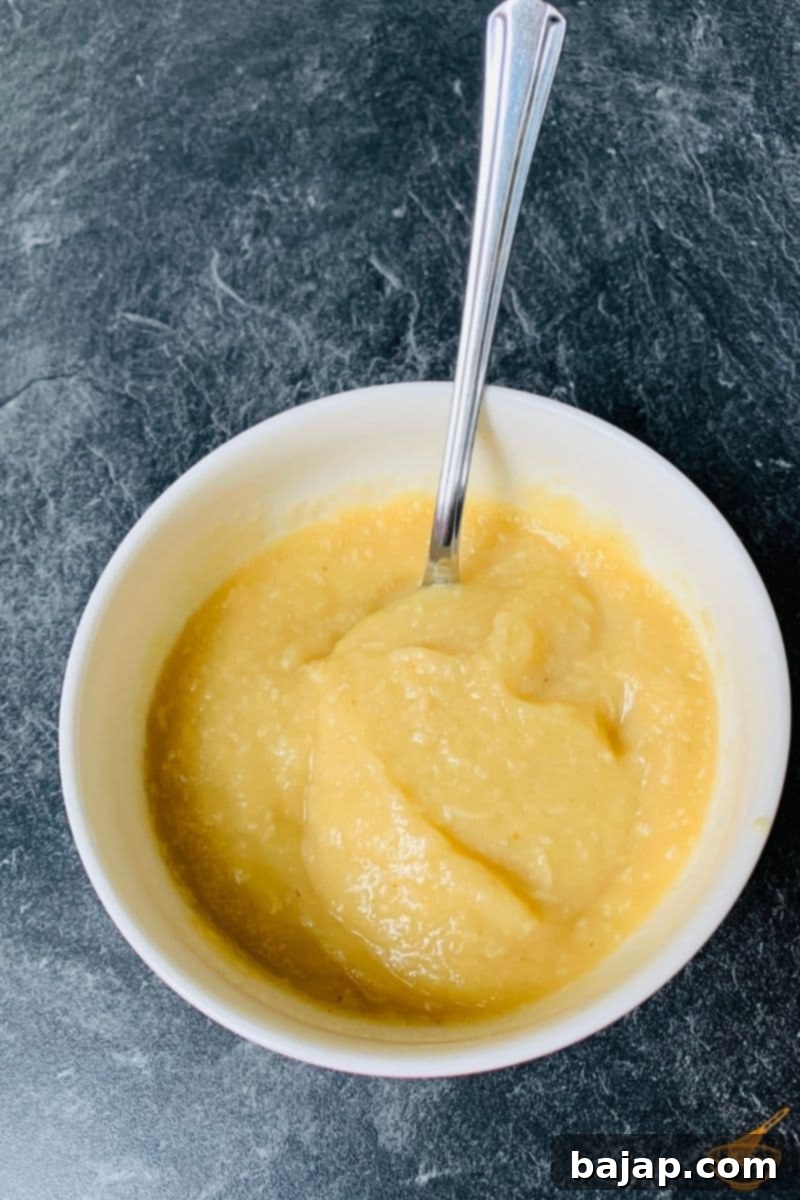
This versatile sauce can be served in a couple of ways: either directly alongside your main dish on the plate or presented in small, individual bowls, allowing each guest to add as much or as little as they prefer. Its vibrant flavor and beautiful creamy texture make it a delightful addition to any meal.
Crafting Your Own Sugar-Free Applesauce for Apfelkren
While store-bought applesauce offers convenience, making your own homemade, sugar-free version is incredibly simple and allows you to control the exact flavor and sweetness. It’s the perfect base for your Apfelkren, ensuring a truly fresh taste.
To make your own:
- Prepare the Apples: Start with approximately 5 apples (about 28.22 oz / 800 g). Peel and coarsely chop them. Firmer, tart varieties like Granny Smith, Honeycrisp, or even a mix of sweet and tart apples work beautifully for applesauce.
- Cook: Place the chopped apples in a large cooking pot. Add 3.38 oz / 100 ml of water and the juice of half a lemon. The lemon juice helps prevent browning and brightens the flavor.
- Simmer: Cook the apples on low heat for about 20-30 minutes, or until they are very soft and easily mashable. Stir occasionally to prevent sticking.
- Blend: Once cooked, remove from heat and use a hand blender (immersion blender) to blend the applesauce until it reaches your desired smoothness. If you prefer a chunkier sauce, blend less. For an extra smooth consistency, you can push it through a fine-mesh sieve, though this is usually not necessary.
Having a supply of delicious homemade applesauce year-round is a fantastic asset for Apfelkren and countless other apple dishes. For those keen on long-term storage, check out Kristen Woods’ comprehensive list of excellent storage apples, perfectly suited for keeping fresh for extended periods.
🙋🏻 Frequently Asked Questions About Horseradish & Apfelkren
What Exactly is Horseradish?
Horseradish, scientifically known as Armoracia rusticana, is a root vegetable famous for its pungent flavor. It belongs to the Brassicaceae family, a diverse group that also includes other well-known vegetables like cabbage, broccoli, kale, radishes, and cress. What we typically refer to as horseradish is the large, white, tapered root of this plant. Historically, it has been cultivated for centuries, not only for its culinary uses but also for its traditional medicinal properties.
What Does Horseradish Taste Like?
If you’re new to horseradish, prepare for a distinctive flavor profile. It delivers a hot, spicy, and peppery taste with a sharp, almost mustard-like aroma. This intense flavor is not from heat (like chili peppers) but from volatile oils (isothiocyanates) that are released when the root cells are crushed or grated. These compounds irritate the sinuses and eyes, creating that characteristic “clear your head” sensation. When combined with a smooth, sweet element like applesauce in Apfelkren, these strong flavors are beautifully balanced, creating a complex and incredibly addictive condiment that enhances rather than overwhelms.
Source: lifesambrosia.com
Are There Health Benefits to Horseradish?
Beyond its vibrant flavor, horseradish boasts an impressive array of health benefits. The mustard oils (isothiocyanates), along with its rich content of vitamins (especially Vitamin C) and various minerals, contribute to its potent properties. Horseradish is known for its disinfecting, cleansing, and circulatory effects. It also exhibits strong antibacterial properties. Historically, it has been used as a natural remedy, particularly recommended as a preventive measure against colds due to its immune-strengthening capabilities. The essential oils and active compound sinigrin also contribute to an antibiotic effect and can help relieve coughs and congestion. Incorporating fresh horseradish into your diet can be a delicious way to boost your overall well-being.
Proper Storage for Horseradish
To maximize the shelf life and potency of your horseradish, proper storage is crucial:
- Fresh, Unpeeled Root: Whole, unpeeled horseradish root can be stored in the refrigerator for at least two weeks, often longer. For best results, wrap it in a slightly moistened cloth (you can dampen it with a little vinegar) and place it in the crisper drawer of your refrigerator. This helps maintain its moisture and prevents it from drying out.
- Freezing: You can freeze both unpeeled roots and grated horseradish. For unpeeled roots, simply wrap them tightly in plastic wrap and then in foil before freezing. For grated horseradish, store it in an airtight container or freezer bag. While freezing is an option, be aware that there may be some loss of its characteristic aroma and spicy kick once thawed.
- Avoid Drying: It is generally not recommended to dry horseradish root. The drying process causes it to lose its volatile oils, which are responsible for its distinctive pungent taste, rendering it significantly less flavorful.
How Long Will Homemade Horseradish Sauce Last?
Your freshly prepared apple horseradish sauce (Apfelkren) stores remarkably well. When kept in an airtight container in the refrigerator, it can maintain its freshness and flavor for up to 3 months. If you notice any separation over time, simply give it a quick stir to re-emulsify before serving. This excellent shelf life makes it a fantastic make-ahead condiment for any occasion.
Source: missinthekitchen.com
🇦🇹 More Delicious Austrian Favorites
If you’ve enjoyed the authentic flavors of Apfelkren, you’ll love exploring more culinary delights from Austria. Here are some other traditional recipes that embody the rich and hearty spirit of Austrian cooking, perfect for expanding your repertoire or planning a full Austrian-themed meal:
- Austrian Zirben Spritzer – White Wine Spritzer with Pine Liqueur
- Braided Bread Wreath
- Baked Rice Pudding
- Austrian Haselnussmakronen – Hazelnut Meringue Cookies
📖 Recipe Card: Austrian Apple Horseradish Sauce (Apfelkren)
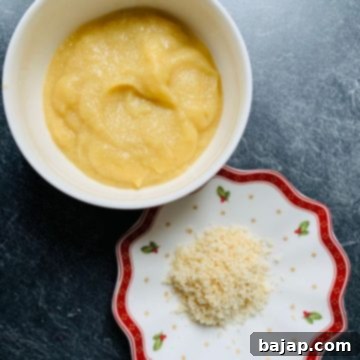
Austrian Horseradish Sauce (Apfelkren)
Nora
Save RecipeSaved!
Pin Recipe
Equipment
-
Small Mixing Bowl
-
Grater (fine grater recommended)
Ingredients
- 360 g Apple Sauce (homemade or high-quality unsweetened store-bought)
- 2-3 tablespoon Fresh Horseradish (finely grated, adjust to desired intensity)
Instructions
-
Carefully peel the outer skin from the horseradish root. Ensure to cut away any green parts beneath the peel, as these can impart a bitter flavor. Finely grate 2-3 tablespoons of horseradish, or more depending on how spicy you prefer your sauce. Remember to grate in a well-ventilated area to avoid eye irritation.
-
Transfer your store-bought or homemade applesauce into a small mixing bowl. Gradually incorporate the freshly grated horseradish, starting with 2 tablespoons.
-
Stir the mixture thoroughly, tasting as you go, until you achieve the perfect balance of sweet and spicy that suits your palate. It’s always easier to add more spice than to tone it down!
-
Your delicious Apfelkren is now ready to serve! Enjoy it immediately on your favorite dishes or in small, separate bowls for guests.
Notes
How to Make Homemade Sugar-Free Applesauce
For the freshest taste, you can easily make your own applesauce without added sugar. Peel and coarsely chop 5 medium apples (approximately 28.22 oz / 800 g). Place them in a large cooking pot with 3.38 oz / 100 ml of water and the juice of half a lemon. Cook over low heat for about 20-30 minutes, stirring occasionally, until the apples are very soft. Blend with a hand blender until smooth, or to your preferred consistency. Let it cool before mixing with horseradish.
Nutrition values are estimates only, using online calculators. Please verify using your own data.

⛑️ Important Food Safety Guidelines
While preparing delicious food, ensuring proper food safety is paramount to prevent foodborne illnesses. Please keep the following guidelines in mind:
- Maintain Proper Cooking Temperatures: Always cook meats to their minimum safe internal temperature. For most poultry, this is 165 °F (74 °C). Use a food thermometer to verify.
- Avoid Cross-Contamination: Never use the same utensils, cutting boards, or dishes on cooked food that have previously come into contact with raw meat without thoroughly cleaning them first.
- Hand Hygiene: Always wash your hands thoroughly with soap and warm water after handling raw meat, poultry, or seafood to prevent the spread of bacteria.
- Temperature Control: Do not leave perishable foods, including your prepared Apfelkren, sitting out at room temperature for extended periods. Refrigerate promptly within two hours (or one hour if the temperature is above 90°F / 32°C).
- Supervise Cooking: Never leave cooking food unattended on the stovetop or in the oven. This can lead to overcooking, burning, or even fires.
- Cooking Oils: When cooking, opt for oils with a high smoking point to avoid the formation of harmful compounds when heated to high temperatures.
- Ventilation: Always ensure good ventilation in your kitchen, especially when using a gas stove, to prevent the buildup of fumes and improve air quality.
For more detailed food safety information and best practices, always refer to reputable sources such as Safe Food Handling – FDA.
This comprehensive guide to homemade Apfelkren (Austrian Apple Horseradish Sauce) covers everything from its history and health benefits to detailed instructions and serving suggestions. We’ve optimized this content for search engines by including relevant keywords such as Apfelkren, Apple Horseradish Sauce, Austrian Sauce, Homemade Horseradish, Gluten-Free, Tafelspitz, and more, ensuring high visibility for those seeking authentic Austrian recipes. The article is structured with clear headings (H1, H2, H3) for readability and features internal links to related recipes, enhancing user experience and site navigation. With over 900 words, it provides an in-depth resource for preparing this delightful sweet and spicy condiment, making it a valuable addition for food enthusiasts and home cooks alike.
